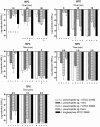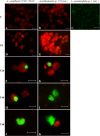Effect of Common Drinking Water Disinfectants, Chlorine and Heat, on Free Legionella and Amoebae-Associated Legionella
- PMID: 26241039
- PMCID: PMC4524690
- DOI: 10.1371/journal.pone.0134726
Effect of Common Drinking Water Disinfectants, Chlorine and Heat, on Free Legionella and Amoebae-Associated Legionella
Abstract
Chlorine and thermal treatments are the most commonly used procedures to control and prevent Legionella proliferation in drinking water systems of large buildings. However, cases of legionellosis still occur in facilities with treated water. The purpose of this work was to model the effect of temperature and free chlorine applied in similar exposure conditions as in drinking water systems on five Legionella spp. strains and two amoebal strains of the genera Acanthamoeba. Inactivation models obtained were used to determine the effectiveness of the treatments applied which resulted more effective against Legionella than Acanthamoeba, especially those in cystic stages. Furthermore, to determine the influence of the relationship between L. pneumophila and Acanthamoeba spp. on the treatment effectiveness, inactivation models of the bacteria-associated amoeba were also constructed and compared to the models obtained for the free living bacteria state. The Legionella-amoeba association did not change the inactivation models, but it reduced the effectiveness of the treatments applied. Remarkably, at the lowest free chlorine concentration, 0.5 mg L-1, as well as at the lowest temperatures, 50°C and 55°C, the influence of the Legionella-amoeba associate state was the strongest in reducing the effectiveness of the treatments compared to the free Legionella state. Therefore, the association established between L. pneumophila and amoebae in the water systems indicate an increased health risk in proximal areas of the system (close to the tap) where lower free chlorine concentrations and lower temperatures are commonly observed.
Conflict of interest statement
Figures







References
-
- EC. Council Directive 98/83/EC of 3 November 1998 on the quality of water intended for human consumption. Off J Eur Communities. 1998;41.
-
- BOE. Real Decreto 865/2003 por el que se establecen los criterios higiénico-sanitarios para la prevención y control de la legionelosis. 2003. 28055–28069.
-
- WHO. Water Safety in Distribution Systems. World Health Organization; 2014.
Publication types
MeSH terms
Substances
LinkOut - more resources
Full Text Sources
Other Literature Sources
Molecular Biology Databases
Miscellaneous

